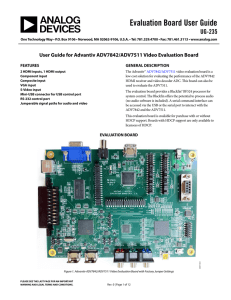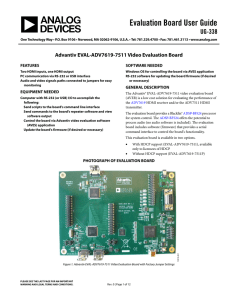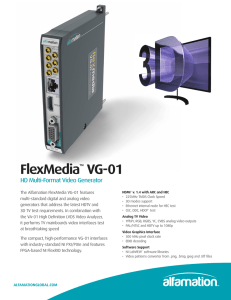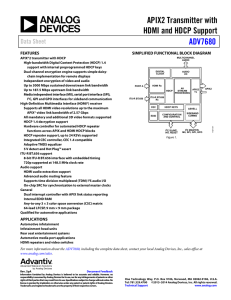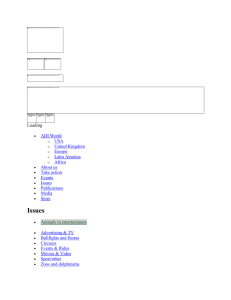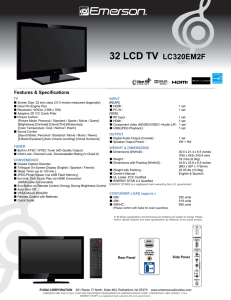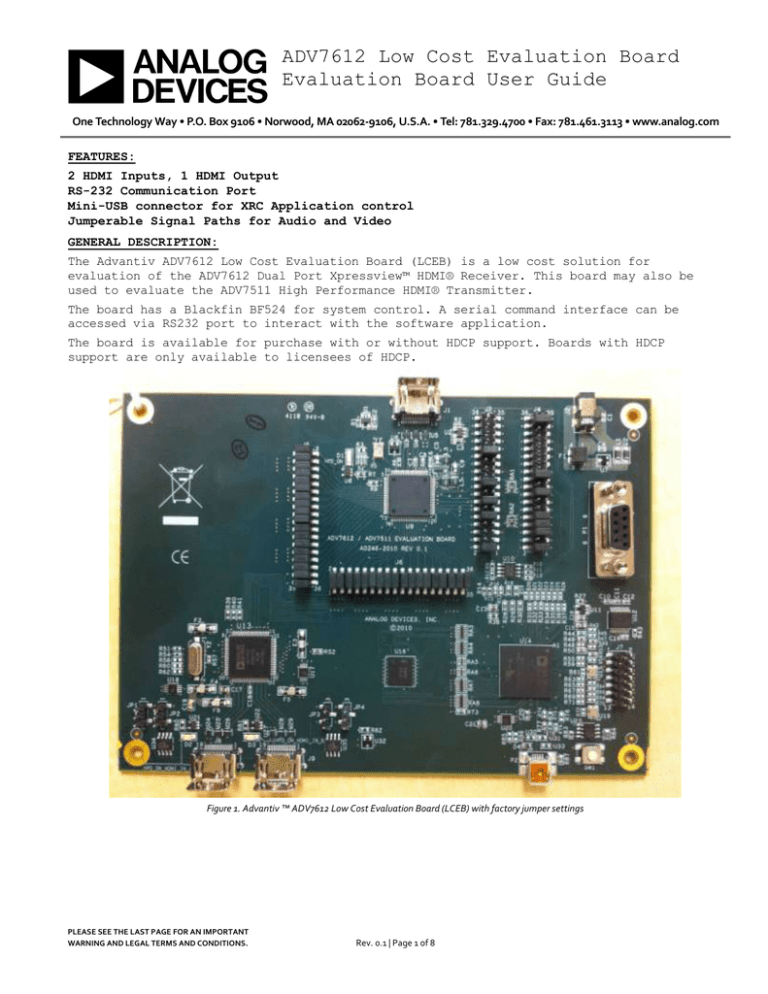
ADV7612 Low Cost Evaluation Board
Evaluation Board User Guide
One Technology Way • P.O. Box 9106 • Norwood, MA 02062-9106, U.S.A. • Tel: 781.329.4700 • Fax: 781.461.3113 • www.analog.com
FEATURES:
2 HDMI Inputs, 1 HDMI Output
RS-232 Communication Port
Mini-USB connector for XRC Application control
Jumperable Signal Paths for Audio and Video
GENERAL DESCRIPTION:
The Advantiv ADV7612 Low Cost Evaluation Board (LCEB) is a low cost solution for
evaluation of the ADV7612 Dual Port Xpressview™ HDMI® Receiver. This board may also be
used to evaluate the ADV7511 High Performance HDMI® Transmitter.
The board has a Blackfin BF524 for system control. A serial command interface can be
accessed via RS232 port to interact with the software application.
The board is available for purchase with or without HDCP support. Boards with HDCP
support are only available to licensees of HDCP.
Figure 1. Advantiv ™ ADV7612 Low Cost Evaluation Board (LCEB) with factory jumper settings
PLEASE SEE THE LAST PAGE FOR AN IMPORTANT
WARNING AND LEGAL TERMS AND CONDITIONS.
Rev. 0.1 | Page 1 of 8
ADV7612 LCEB User Guide
Figure 2- ADV7612 LCEB Assembly Drawing (top side)
Table 1. Evaluation Board Hardware Components
Component
Function
Description
J8, J9
J1
P1
P2
SW1
J2
J7
HDMI Inputs
HDMI Output
RS232 Port
USB Port
Reset
Power
BF524 JTAG
JP1, JP2
Port A EDID
JP3, JP4
Port B EDID
J3, J4
Audio /
Control
Jumpers
Video Jumpers
J8 is HDMI Port A, J9 is HDMI Port B
The is the only video output connector
RS232 port for communicating with the application software
USB port for PC-based control (XRC)
This switch will reset the Blackfin
J1 is where the 5V, 2.5A power supply is connected
The ICE-100B or the HPUSB-ICE is connected here to reprogram the system
flash or do source code debugging
These jumpers (lower left) connect the I2C bus from the Blackfin to the
EDID EEPROM
These jumpers (bottom middle) connect the I2C bus from the Blackfin to
the EDID EEPROM
The audio bus can be jumpered between 3 configurations on these
connectors. They also have several control signals available for probing
as well as video synchs and clock
The digital video pixelbus signals are jumpered here for easy evaluation
J5,J6
Rev. 0 .1| Page 2 of 8
ADV7612 LCEB User Guide
BLOCK DIAGRAM:
TERMINOLOGY:
Throughout this document, certain terms will be used:
“Source” plays video out of a standard video port. This includes DVDs, cameras, set
top boxes, Blu-ray players, game consoles or any other device with a video output of
any of the types supported by the board.
“Sink” accepts video in through a standard video port. This will nearly always be an
HDMI display (monitor or TV) in the context of this evaluation board.
"Repeater” refers to the software that implements the link between Source and Sink
with respect to this board, and which runs on the BF524.
Rev. 0 .1| Page 3 of 8
ADV7612 LCEB User Guide
EVALUATION BOARD USAGE:
The evaluation board can be connected in the ways shown in Figure 3. By default, the
video buses of the ADV7612 and ADV7511 are directly connected and the I2S/SPDIF
outputs of the ADV7612 are directly connected to the I2S / SPDIF inputs of the
ADV7511.
All video inputs are available on both the versions of the board. Note that a board
which is NOT HDCP enabled will not work with most consumer HDMI sources, so a non-HDCP
video source would be needed. An HDCP license is required to purchase an HDCP-enabled
board. No license is required to purchase the non HDCP-enabled board.
The RS232 command-line interface operates at 115200 baud, 8 data bits, no parity, 1
stop bits and no flow control. Typing „help‟ via RS232 will list the commands that can
be used to control the board as well as indicate the version of firmware and build
date.
If the board is HDCP-enabled, then ADI‟s Repeater software will start on boot allowing
an HDMI sink to receive content from an HDMI/HDCP source soon after they are
connected.
Individual registers can be read and written from/to the ADV7612 and ADV7511. There
are three main ways to control the board:
1. COMMAND LINE W/O REPEATER
This mode uses the RS232 command-line interface. The BF524 will boot to a known reset
state and registers can be read/written directly. In this case, it is safe to assume
that all registers will be at their reset value. For a board without HDCP enabled,
this is the normal state on boot for the board. A board with HDCP enabled will start
the repeater on boot.
It is possible to start the repeater in this mode with the “startrep” command via
RS232. This will only work with HDCP protected sources on an HDCP-enabled board. A non
HDCP-enabled board will still operate but will not support HDCP.
2. COMMAND LINE W/REPEATER
This Command Line w/Repeater mode also uses the RS232 command-line interface and is
the typical evaluation control/interface recommended for an HDCP-enabled board.
Messages from the repeater will be seen on the console as the repeater goes about the
normal business of maintaining an encrypted HDMI link as sources, sinks, or formats
change. Registers can still be read/written from the command line but anything that is
written to a register could get overwritten by the repeater software.
In this mode there are additional commands from the repeater itself. All repeater
commands are of the format “rep XXX” where XXX is the repeater command. A list of
repeater commands is displayed using the “rep help” command. These commands will
provide information about the state of the repeater, source, and sink.
3. DVP EVAL SOFTWARE / XRC
The DVP Eval / XRC Software runs on a PC and uses the USB connection. Evaluation
software may be downloaded from the location indicated on the card enclosed with the
board (typically on the EngineerZone support community at http://ez.analog.com). This
software allows scripts to be run from a PC to control the ADV7612 and ADV7511.
For a non-HDCP-enabled board, this software is the easiest way to evaluate different
modes of the ADV7612 and ADV7511. “DVP Eval Software” and “XRC” are used
interchangeably.
Rev. 0 .1| Page 4 of 8
ADV7612 LCEB User Guide
JUMPERS:
As mentioned previously, this evaluation board has all of the digital audio/video
signals (as well as some control signals) connected to 0.1" pins. This was provided in
order to provide the users with maximum flexibility when evaluating the devices.
The arrangement of the pins/signals in the schematic does match the physical
arrangement on the board. The following diagrams match the physical arrangement on
the board and may be useful when probing these signals:
J5:
Note: Factory (default) setting is for jumpers installed on all odd/even pairs
J6:
Note: Factory (default) setting is for jumpers installed on all odd/even pairs
Rev. 0 .1| Page 5 of 8
ADV7612 LCEB User Guide
J3:
Note: Factory (default) setting is for jumpers installed on the following pairs:
1-2, 9-10, 13-14, 17-18, 25-26
J4:
Note: Factory (default) setting is for jumpers installed on the following pairs:
1-2, 5-6, 7-8, 9-10, 15-16, 19-20, 33-34
Rev. 0 .1| Page 6 of 8
ADV7612 LCEB User Guide
PROGRAMMING THE BF524:
The Blackfin can be reprogrammed and source-code debugged through the JTAG connector
J7. It is possible to program and debug source code using standard Blackfin
development tools: Visual DSP++ and the HPUSB-ICE. A low cost debugger is also
available: ICE-100B. This could be used to simply reprogram the SPI flash with new
firmware for the board. The latest firmware release for the board can be found at the
location indicated on the card enclosed with the board (typically on the EngineerZone
support community at http://ez.analog.com). At a minimum, the ICE-100B and a Visual
DSP++ Test Drive are required to reprogram the board.
A flash driver is needed by the Flash Programmer in Visual DSP++. It‟s also available
for download at the location indicated on the card enclosed with the board (typically
on the EngineerZone support community at http://ez.analog.com).
For information regarding audio and the BF524, please refer to the Blackfin Data
Sheet, which can be found at http://www.analog.com/static/importedfiles/data_sheets/ADSP-BF522_BF523_BF524_BF525_BF526_BF527.pdf
Rev. 0 .1| Page 7 of 8
ADV7612 LCEB User Guide
NOTES:
ESD Caution
ESD (electrostatic discharge) sensitive device. Charged devices and circuit boards can discharge without detection. Although this product features patented or proprietary protection
circuitry, damage may occur on devices subjected to high energy ESD. Therefore, proper ESD precautions should be taken to avoid performance degradation or loss of functionality.
Legal Terms and Conditions
By using the evaluation board discussed herein (together with any tools, components documentation or support materials, the “Evaluation Board”), you are agreeing to be bound by the terms and conditions set
forth below (“Agreement”) unless you have purchased the Evaluation Board, in which case the Analog Devices Standard Terms and Conditions of Sale shall govern. Do not use the Evaluation Board until you have
read and agreed to the Agreement. Your use of the Evaluation Board shall signify your acceptance of the Agreement. This Agreement is made by and between you (“Customer”) and Analog Devices, Inc. (“ADI”),
with its principal place of business at One Technology Way, Norwood, MA 02062, USA. Subject to the terms and conditions of the Agreement, ADI hereby grants to Customer a free, limited, personal, temporary,
non-exclusive, non-sublicensable, non-transferable license to use the Evaluation Board FOR EVALUATION PURPOSES ONLY. Customer understands and agrees that the Evaluation Board is provided for the sole
and exclusive purpose referenced above, and agrees not to use the Evaluation Board for any other purpose. Furthermore, the license granted is expressly made subject to the following additional limitations:
Customer shall not (i) rent, lease, display, sell, transfer, assign, sublicense, or distribute the Evaluation Board; and (ii) permit any Third Party to access the Evaluation Board. As used herein, the term “Third Party”
includes any entity other than ADI, Customer, their employees, affiliates and in-house consultants. The Evaluation Board is NOT sold to Customer; all rights not expressly granted herein, including ownership of
the Evaluation Board, are reserved by ADI. CONFIDENTIALITY. This Agreement and the Evaluation Board shall all be considered the confidential and proprietary information of ADI. Customer may not disclose or
transfer any portion of the Evaluation Board to any other party for any reason. Upon discontinuation of use of the Evaluation Board or termination of this Agreement, Customer agrees to promptly return the
Evaluation Board to ADI. ADDITIONAL RESTRICTIONS. Customer may not disassemble, decompile or reverse engineer chips on the Evaluation Board. Customer shall inform ADI of any occurred damages or any
modifications or alterations it makes to the Evaluation Board, including but not limited to soldering or any other activity that affects the material content of the Evaluation Board. Modifications to the Evaluation
Board must comply with applicable law, including but not limited to the RoHS Directive. TERMINATION. ADI may terminate this Agreement at any time upon giving written notice to Customer. Customer agrees
to return to ADI the Evaluation Board at that time. LIMITATION OF LIABILITY. THE EVALUATION BOARD PROVIDED HEREUNDER IS PROVIDED “AS IS” AND ADI MAKES NO WARRANTIES OR
REPRESENTATIONS OF ANY KIND WITH RESPECT TO IT. ADI SPECIFICALLY DISCLAIMS ANY REPRESENTATIONS, ENDORSEMENTS, GUARANTEES, OR WARRANTIES, EXPRESS OR IMPLIED, RELATED TO
THE EVALUATION BOARD INCLUDING, BUT NOT LIMITED TO, THE IMPLIED WARRANTY OF MERCHANTABILITY, TITLE, FITNESS FOR A PARTICULAR PURPOSE OR NONINFRINGEMENT OF
INTELLECTUAL PROPERTY RIGHTS. IN NO EVENT WILL ADI AND ITS LICENSORS BE LIABLE FOR ANY INCIDENTAL, SPECIAL, INDIRECT, OR CONSEQUENTIAL DAMAGES RESULTING FROM CUSTOMER’S
POSSESSION OR USE OF THE EVALUATION BOARD, INCLUDING BUT NOT LIMITED TO LOST PROFITS, DELAY COSTS, LABOR COSTS OR LOSS OF GOODWILL. ADI’S TOTAL LIABILITY FROM ANY AND
ALL CAUSES SHALL BE LIMITED TO THE AMOUNT OF ONE HUNDRED US DOLLARS ($100.00). EXPORT. Customer agrees that it will not directly or indirectly export the Evaluation Board to another country,
and that it will comply with all applicable United States federal laws and regulations relating to exports. GOVERNING LAW. This Agreement shall be governed by and construed in accordance with the substantive
laws of the Commonwealth of Massachusetts (excluding conflict of law rules). Any legal action regarding this Agreement will be heard in the state or federal courts having jurisdiction in Suffolk County,
Massachusetts, and Customer hereby submits to the personal jurisdiction and venue of such courts. The United Nations Convention on Contracts for the International Sale of Goods shall not apply to this
Agreement and is expressly disclaimed.
©2010 Analog Devices, Inc. All rights reserved. Trademarks and
registered trademarks are the property of their respective owners.
UG09299-0-10/10(0)
Rev. 0 .1| Page 8 of 8

